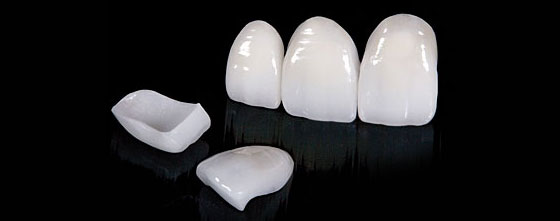
For those people who wear partial dentures that may need to restore from the ageing effects of wear and decay of their natural teeth, I can offer technical advice with the use of ceramic crown and bridge work or total replacement of a single tooth with a prosthetic implant.
For single or multiple natural teeth to be rebuilt, I can offer ceramic crowns with inner alloy core or whole ceramic crowns with zirconia core. Crowns made on an alloy core present a high fracture resistant restoration, whilst the all ceramic zirconia crown has also a high fracture resistance, but is more natural and life like in the light behavioural properties. Most ceramic bridge work today, is constructed with metal core but with the introduction of zirconia materials some 15 years ago, more multiple unit bridges today are successfully made on zirconia frameworks, as long as specific clinical preparatory guidelines are followed.
All these ceramic restorations mentioned, can be effectively constructed within the parameters of existing partial denture, framework and attachments and certain devices, can be incorporated in the crown or bridge for the partial denture to attach itself to. For single missing teeth or future teeth to be extracted, especially in the front section of the mouth and with neighbouring natural teeth adjacent to the missing space, the use of a suitably sized implant maybe recommended, eliminating the reduction of neighbouring natural teeth for a three unit bridge.
Once the titanium implant is drilled into the jaw bone, the bone fuses to the titanium surface to which a 3 to 4 month healing period is allowed for, before construction of a prosthetic ceramic crown. Again most ceramic crowns that are screwed onto implants today, are constructed on an alloy core. In Australia most prosthetic crowns are made to be retrievable, with a screw directly to the implant or with a side screw to a separate additional alloy core which is also screwed on the implant. A side screw to separate alloy core method, is commonly performed on misplaced or crookedly positioned implants, so that the core is angled to provide a level and straight position for the prosthetic crown which will symmetrically harmonise with neighbouring teeth.
The ceramic restorations are meticulously hand sculpted from german engineered 3D ceramic powders of finer particle size 7 micron thickness, to display a balance of bright and transparent light properties, that are characteristic of the natural tooth body called dentine and the tip of the tooth which is called the enamel. The all 360 degree porcelain surface of the restoration is baked for its light effects, as well as exhibiting high compressive strength when the ceramic cools after final glazing, it literally goes into compaction.
At the dental laboratory, we personally analyse the colouring of the surrounding natural teeth with a tooth shade guide, in which we use to decide a match for the restorative colour. Patients may also choose their desired colour, especially when restoring a number of front teeth. The construction and provision of ceramic veneers, crowns, bridges and implant borne crown work, we work closely through a selected number of dentists or dental surgeons, who prepare and finally fixate the finished restoration in the mouth.
